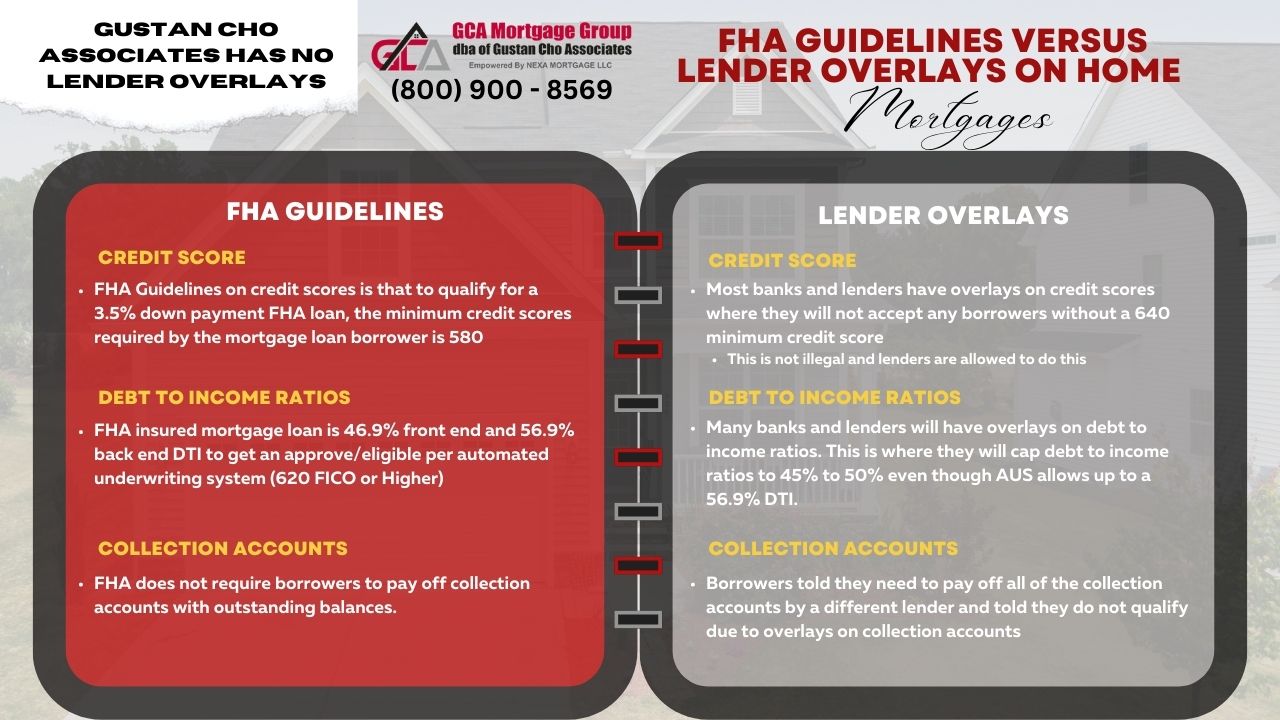FHA Guidelines Versus Lender Overlays on FHA Loans
In this blog, we will cover the difference between FHA guidelines versus lender overlays on FHA loans. All mortgage lenders need to follow HUD guidelines if they want the loans they originate and fund insured by the Federal Housing Administration. HUD, the parent of FHA, insures lenders against the borrower defaulting on their FHA loans. In order to be able to sell all of their FHA loans they originate and fund to the secondary mortgage markets, all loans need to meet HUD Guidelines.
Gustan Cho Associates has no lender overlays on FHA loans. Banks and credit unions are known to have a lot of overlays on government loans. If you have less than perfect credit, it is best that you know the minimum HUD guidelines so if you are told you do not qualify for an FHA loan by one lender, you know you are able to qualify for a loan at a different lender without lender overlays on FHA loans.
If lenders do not abide by HUD mortgage guidelines and the FHA file misses any of lending guidelines when the HUD DE mortgage underwriter has issued a clear to close, then the Loan is not insurable. The lender cannot sell the mortgage loan on the secondary bond market. In this article, we will discuss and cover FHA Guidelines Versus Lender Overlays on Home Mortgages.
How The Mortgage Process Works
Lenders who are mortgage bankers have a warehouse line of credit. They use this line of credit to fund borrower’s FHA loans. Once they fund mortgage loans, lenders package these Loans and sell them to the secondary mortgage markets. With the proceeds of the sale of the FHA mortgage notes, they pay down their wholesale line of credit. This is done so they can free it up to use it to originate and fund more mortgage loans.
Gustan Cho Associates has a national reputation of no lender overlays on FHA loans. Over 80% of our clients are folks who could not qualify at other lenders for an FHA loan due to that lender having overlays.
HUD, the United States Department of Housing and Urban Development, is the parent of FHA and has created the HUD FHA 4000.1 Handbook. HUD 4000.1 FHA Handbook Guidelines is over 900 pages of FHA Guidelines and Requirements. Every single FHA Loan needs to meet HUD guidelines in order for it to be insurable and sellable on the secondary market.
Do All Lenders Have Overlays on FHA Loans?
All lenders follow HUD guidelines for FHA loans. However, most lenders have mortgage lender overlays which are lending requirements that are on top of the minimum HUD guidelines. Just because a mortgage loan applicant meets the minimum HUD mortgage lending guidelines does not mean that a bank or mortgage lender will originate and fund the FHA loan.
Not all mortgage lenders have the same lending requirements on FHA loans. Not all mortgage lenders have lender overlays on FHA loans. Gustan Cho Associates has no lender overlays on FHA loans.
Some FHA mortgage lenders have tougher requirements than others. Banks are known to have tougher mortgage lending guidelines than most mortgage companies. Not all lenders have the same FHA Guidelines. Just because a borrower does not qualify with one lender does not mean they do not qualify with another lender.
FHA Guidelines Versus Lender Overlays on Credit Score Requirements
A substantial percentage of our borrowers at Gustan Cho Associates come to us because they either did not qualify with another lender or were denied an FHA loan by another lender due to their overlays.
The team at Gustan Cho Associates has helped thousands of borrowers with credit scores down to 500 FICO get approved for FHA and VA loans with bad credit and manual underwriting.
HUD guidelines on credit scores is that to qualify for a 3.5% down payment FHA loan, the minimum credit scores required by the mortgage loan borrower is 580. However, most banks and lenders have overlays on credit scores where they will not accept any borrowers without a 640 minimum credit score. Even though HUD will insure lenders on loan applicants with 580 credit scores, they do not care.
Getting Denied For an FHA Loan Due To Overlays
Majority of our borrowers at Gustan Cho Associates are homebuyers who got a mortgage loan denial at other lenders due to overlays. Typical lender overlays are overlays on credit scores, debt-to-income ratio, collections, charge-offs, and late payments. The particular lender may want to set higher standards for their lending institution. They can create a higher credit score minimum requirement. This is not illegal and lenders are allowed to do this. Lenders are not required to accept the minimum FHA credit score requirements set by HUD.
Over 80% of our clients are borrowers who could not qualify at other lenders due to lender overlays. Gustan Cho Associates has no lender overlays on government and conventional loans.
Borrowers looking for a lender with no overlays on credit scores and will originate and fund borrowers with credit scores down to 580, contact us at Gustan Cho Associates at 800-900-8569 or text us for a faster response. Or email us at gcho@gustancho.com. Our national team of licensed and support mortgage professionals are available 7 days a week and have no overlays on government and conventional loans.
FHA Guidelines Versus Lender Overlays On Debt To Income Ratios
FHA Guidelines on Debt To Income Ratios are as follows:
- Borrowers with credit scores of 620 or higher, the maximum debt to income ratios required to qualify for an FHA insured mortgage loan is 46.9% front end and 56.9% back end DTI to get an approve/eligible per automated underwriting system
- Borrowers with credit scores of under 620 then the maximum debt to income ratios required to qualify for an FHA insured mortgage loan is 43% DTI in general to get an approve/eligible per automated underwriting system
However, many banks and lenders will have overlays on debt to income ratios. This is where they will cap debt to income ratios to 45% to 50% even though AUS allows up to a 56.9% DTI. Some lenders will go up to 50% debt to income ratios if borrowers have credit scores of higher than 680.
FHA Loans With High Debt-To-Income Ratios
Borrowers with higher debt to income ratios and were told they do not qualify for an FHA loan by other banks and lenders do to their overlays on debt to income ratios, contact us at Gustan Cho Associates at 800-900-8569 or text us for a faster response. Or email us at gcho@gustancho.com. Gustan Cho Associates has no lender overlays on debt to income ratios and can go up to 56.9% DTI back end and 46.9% front end. We just go off automated underwriting system findings and have zero overlays.
FHA Guidelines Versus Lender Overlays on Collection Accounts
HUD does not require borrowers to pay off collection accounts with outstanding balances. However, most banks and lenders will require borrowers do not have any outstanding collection account balances in order for them to qualify for an FHA loan with their institution. This is not the case and we do not require collection accounts with outstanding balances to be paid off. Charge-offs and medical collection accounts are exempt from debt to income calculation requirements.
Outstanding collection accounts does not have to be paid off to qualify for FHA loans. Charge off accounts do not have to be paid off to qualify for an FHA loan at Gustan Cho Associates.
With non-medical collection accounts with outstanding balances of greater than $2,000, HUD requires that 5% of the outstanding collection account balance be used to calculate the borrower’s debt to income ratios. If the 5% of the outstanding collection account balance is too much where the borrower cannot qualify for the FHA loan due to higher debt to income ratios, HUD will allow borrowers to enter into a written payment agreement with the creditor and/or collection agency and set up a payment agreement. That monthly payment agreement will be used in lieu of the 5% of the outstanding collection account balance.
Impact of Lender Overlays on Borrowers
How Overlays Affect Loan Eligibility
- Stricter Credit Score Requirements:
- Lenders may require higher credit scores than the FHA minimum of 580 for a 3.5% down payment. Some lenders might set their minimum at 620 or higher.
- Borrowers with lower credit scores may find qualifying difficult, even if they meet FHA guidelines.
- Higher Debt-to-Income (DTI) Ratios:
- FHA guidelines typically allow a maximum DTI ratio of 43%. However, lenders may impose lower limits, such as 36% or 40%.
- Borrowers with higher DTIs might be ineligible for loans from certain lenders.
- Increased Down Payment Requirements:
- While FHA requires a 3.5% down payment with a credit rating of 580 or higher, lenders may need a higher down payment, especially for lower credit scores.
- Borrowers might need to save more for their down payment than initially anticipated.
- Additional Documentation and Verification:
- Lenders may ask for more extensive documentation than FHA guidelines require, such as multiple years of tax returns, additional employment verification, or more detailed financial statements.
- This can make the application process more cumbersome and time-consuming for borrowers.
- Stricter Property Appraisal Standards:
- Some lenders might have more rigorous appraisal requirements, potentially leading to higher repair demands or appraisal disputes.
- Due to these stricter standards, borrowers might need more time to avoid additional costs or delays in the loan approval process.
Challenges Faced by Borrowers Due to Overlays
- Limited Loan Options:
- Due to overlays, borrowers with lower credit scores, higher DTIs, or limited down payments might find fewer lenders willing to work with them.
- This limitation can reduce the borrower’s negotiating power and access to competitive rates.
- Increased Loan Costs:
- Higher down payment requirements and stricter DTI limits can force borrowers to use more of their savings or secure additional financing, increasing overall loan costs.
- Additional documentation and verification may also incur higher administrative costs or fees.
- Longer Approval Process:
- The need for extra documentation and verification can extend the time to get loan approval.
- Borrowers may experience delays in closing, which can be problematic in competitive housing markets.
- Higher Risk of Denial:
- Stricter lender requirements increase the chances of loan denial, even if the borrower meets FHA guidelines.
- Borrowers may need multiple rejections before finding a lender to approve their loan.
Strategies to Overcome Lender Overlays
- Improve Credit Score:
- Work on paying down debt, making timely payments, and reducing credit card balances to boost your credit score.
- Consider working with a credit counselor or using credit-building tools to improve your score.
- Reduce Debt-to-Income Ratio:
- Pay off existing debts to lower your DTI ratio.
- Increase your income through additional employment or side gigs to improve your DTI ratio.
- Save for a Larger Down Payment:
- Create a budget and savings plan to set aside more funds for your down payment.
- Explore down payment assistance programs or awards that may be available to you.
- Shop Around for Lenders:
- Compare multiple lenders to find those with fewer or no overlays.
- Work with a mortgage broker who can help identify lenders that match your financial profile.
- Provide Comprehensive Documentation:
- Gather all necessary documents in advance, including tax returns, payroll slips, bank statements, and proof of additional income.
- Be prepared to explain any financial anomalies or gaps in employment.
- Seek Pre-Approval:
- Obtain pre-approval from multiple lenders to understand their specific requirements and identify potential challenges early in the process.
- Use pre-approval as a tool to negotiate better terms with lenders.
- Consider Alternative Loan Programs:
- Explore other loan options, such as VA, USDA, or conventional loans, with different requirements and less stringent overlays.
- Evaluate the pros and cons of each program to determine the best fit for your situation.
Conclusion
Lender overlays can significantly impact borrowers by imposing stricter requirements than FHA guidelines. By understanding these overlays and adopting strategies to meet or mitigate them, borrowers can improve their chances of securing an FHA loan and achieving homeownership. Shopping around for lenders, improving financial profiles, and being well-prepared with documentation are key steps to overcoming the challenges lender overlays pose.
Frequently Asked Questions (FAQs)
1. What are FHA guidelines?
FHA guidelines are the rules and standards established by the Federal Housing Administration to ensure that borrowers meet certain criteria for obtaining an FHA-insured mortgage. These guidelines cover minimum credit scores, down payment requirements, income and employment verification, and property standards.
2. What are lender overlays?
Lender overlays are additional rules or requirements individual lenders impose on top of the FHA guidelines. These overlays mitigate risk and ensure borrowers meet the lender’s risk tolerance. Overlays can vary significantly from one lender to another and include stricter credit score requirements, higher debt-to-income ratios, or additional documentation.
3. How do FHA guidelines differ from lender overlays?
FHA guidelines are standardized and apply to all FHA loans, ensuring a consistent baseline for qualifying borrowers. In contrast, lender overlays are unique to each lender and can add more stringent requirements. For example, while the FHA may require a minimum credit rating of 580 for a 3.5% down payment, a lender might impose an overlay requiring a minimum score of 620.
4. Why do lenders impose overlays on FHA loans?
Lenders impose overlays to reduce the risk of loan defaults and to ensure they are lending to borrowers who are more likely to settle their loans. Overlays help lenders manage their risk exposure and protect their investments, particularly in uncertain economic times or when dealing with borrowers who may not meet the lender’s internal risk criteria.
5. Can lender overlays affect my ability to get an FHA loan?
Yes, lender overlays can impact your ability to qualify for an FHA loan. If a lender’s overlays are more stringent than the FHA’s baseline guidelines, you may find it harder to meet their requirements. However, it’s important to remember that not all lenders have the same overlays, so shopping around and comparing lenders can help you find one with requirements that you meet.
6. How can I find a lender with fewer overlays?
To find a lender with fewer overlays, you can:
*Research and compare multiple lenders to understand their specific requirements.
*Work with a mortgage broker who can help match you with lenders with more lenient overlays.
*Ask lenders about their overlays and how they might differ from FHA guidelines.
7. Do all FHA loans have lender overlays?
Not all FHA loans have lender overlays. Some lenders may strictly adhere to FHA guidelines without adding extra requirements, while others may impose overlays to reduce risk. When discussing loan options with potential lenders, it’s essential to inquire about overlays.
8. What are common lender overlays on FHA loans?
Common lender overlays on FHA loans include:
*Higher minimum credit score requirements
*Lower maximum debt-to-income (DTI) ratios
*Additional documentation for income and employment verification
*Stricter property appraisal standards
*Higher down payment requirements for borrowers with lower credit scores
9. Can lender overlays change over time?
Yes, lender overlays can change over time based on market status, economic factors, and changes in a lender’s risk management strategy. It’s important to stay informed about current lending standards and to check with lenders regularly for any updates to their overlays.
10. How do overlays impact first-time homebuyers?
Overlays can make it more challenging for first-time homebuyers to qualify for an FHA loan, especially if they need more credit records or higher credit scores. However, understanding FHA guidelines and shopping around for lenders with fewer overlays can help first-time homebuyers find suitable financing options.
11. What should I do if I can’t meet a lender’s overlays?
If you can’t meet a lender’s overlays, consider the following steps:
*Improve your credit score or financial profile to meet the stricter requirements.
*Look for another lender with more lenient overlays or no overlays.
*Work with a mortgage broker who can help you find lenders that match your financial situation.
*Explore other loan programs that have more flexible requirements.
Get Approved With Lender With No Overlays
Borrowers told they need to pay off all of the collection accounts by a different lender and told they do not qualify due to overlays on collection accounts, please contact us at Gustan Cho Associates at 800-900-8569 or text us for a faster response. Or email us at gcho@gustancho.com. We have no lender overlays on collection accounts and will be able to help borrowers with less than perfect credit and higher debt to income ratios. We have no overlays with FHA, VA, USDA, and Conventional loans.










